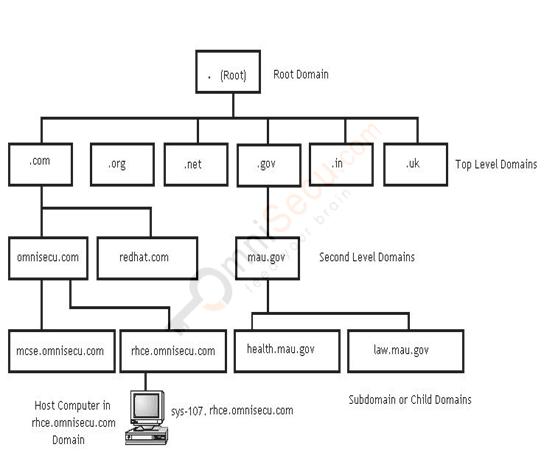Introduction to Domain Name System (DNS) in Linux and what is Berkeley Internet Name Domain (BIND)
A Domain Name System (DNS) server, or name server, is used to resolve an IP address to a hostname or vice versa. Berkeley Internet Name Domain (BIND) is the most commonly used DNS server on the Internet, especially on Unix-like systems.
DNS naming system is a hierarchical and logical tree structure called the DNS namespace. The DNS namespace has a unique root that can have any number of subdomains. In turn, each subdomain can have more subdomains. The Root in the Internet namespace has many top-level domain names, one of which is com. The domain com can have a subdomain for example, omnisecu.com, can have further subdomains like mcse.omnisecu.com and rhce.omnisecu.com. Organizations can also create private networks and use their own private DNS namespaces that are not visible on the Internet.
Features of Domain Name System (DNS)
• Domain Name System (DNS) provides name resolution services to the client computers.
• Domain Name System (DNS) provides IP address to hostname mapping.
• Linux DNS Servers can operate in three modes and these modes are, Caching only DNS server, Primary DNS server and Slave (secondary) DNS server.
• Replication of DNS database between servers
Some important terms related with Domain Name System (DNS)
• Domain: A Domain is any tree or sub-tree within the overall domain namespace.
• Root Domain: Root Domain is the root of the DNS tree. It is unnamed and is represented by a period (.).
• Top-level Domain: Usually top-level domain name is a two or three character name code that identifies the organizational or geographical status for the domain name.
Example, .com, .biz, .net, .org, .gov, .in, .au etc.
• Second-level Domain: A second level domain is a unique name of variable length assigned to individuals or organizations that connect to the internet. Example: myuniversity.edu. Here second level name refers to “.myuniversity”, which is assigned by InterNIC.
• Sub Domains: Large organizations can further subdivide its registered domain name by adding subdivisions that are represented by separate name portion.
Example: mcse.omnisecu.com, rhce.omnisecu.com
• Fully Qualified Domain Name (FQDN): The entire hostname with its domain suffix such as sys-102.gas.chevron.com is called a Fully Qualified Domain Name (FQDN).
• DNS Zone: As shown in above figure, DNS namespace is hierarchical. Administratively, each level or node in the hierarchy represents a potential boundary of authority for management of the name space. A DNS zone is a portion of the global Domain Name System (DNS) namespace for which administrative responsibility has been delegated.
Domain Name System (DNS) Naming Standards
The following characters are valid for DNS.
1) A – Z
2) a – z
3) 0 – 9
4) hyphen (-)
